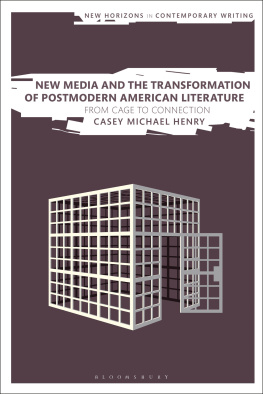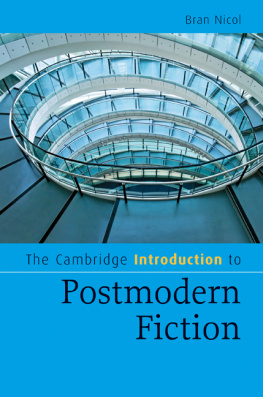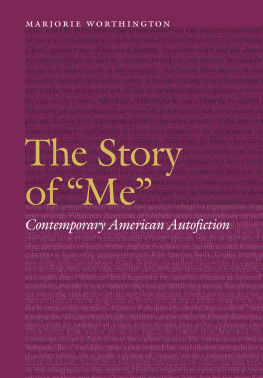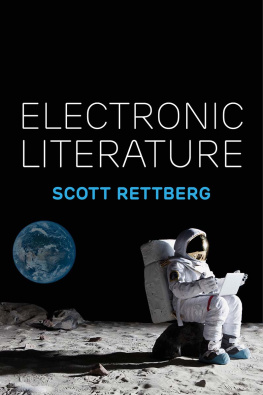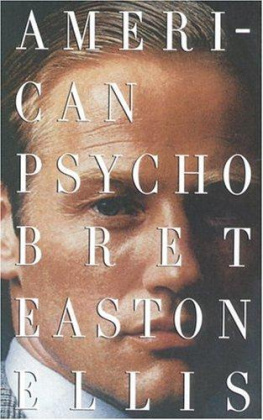New Media and the Transformation of Postmodern American Literature
New Horizons in Contemporary Writing
In the wake of unprecedented technological and social change, contemporary literature has evolved a dazzling array of new forms that traditional modes and terms of literary criticism have struggled to keep up with. New Horizons in Contemporary Writing presents cutting-edge research scholarship that provides new insights into this unique period of creative and critical transformation.
Series Editors
Martin Eve and Bryan Cheyette
Editorial Board:
Sin Adiseshiah (University of Lincoln, UK), Sara Blair (University of Michigan, USA), Peter Boxall (University of Sussex, UK), Robert Eaglestone (Royal Holloway, University of London, UK), Rita Felski (University of Virginia, USA), Rachael Gilmour (Queen Mary, University of London, UK), Caroline Levine (University of WisconsinMadison, USA), Roger Luckhurst (Birkbeck, University of London, UK), Adam Kelly (York University, UK), Antony Rowland (Manchester Metropolitan University, UK), John Schad (Lancaster University, UK), Pamela Thurschwell (University of Sussex, UK), Ted Underwood (University of Illinois at UrbanaChampaign, USA).
Volumes in the series
David Mitchells Post-Secular World , Rose Harris-Birtill
Life Lines: Writing Transcultural Adoption , John McLeod
New Media and the Transformation of Postmodern American Literature , Casey Michael Henry
The Politics of Jewishness in Contemporary World Literature , Isabelle Hesse
South African Literatures Russian Soul , Jeanne-Marie Jackson
Transatlantic Fictions of 9/11 and the War on Terror , Susana Arajo
Wanderwords: Language Migration in American Literature , Maria Lauret
Writing after Postcolonialism: Francophone North African Literature in Transition , Jane Hiddleston
Forthcoming volumes
The Contemporary Post-Apocalyptic Novel , Diletta De Cristofaro
Contemporary Posthumanism , Grace Halden
Jonathan Lethem and the Galaxy of Writing , Joseph Brooker
Northern Irish Writing after the Troubles , Caroline Magennis
Postcolonialism after World Literature , Lorna Burns
New Media and the Transformation of Postmodern American Literature
From Cage to Connection
Casey Michael Henry

Contents
Sudden awakening to the fact that the mischief is irretrievably done: Epiphanic structure in Infinite Jest from Section Three is derived in part from an article published in Critique: Studies in Contemporary Fiction, 2015, copyright Taylor & Francis, available online: http://www.tandfonline.com/10.1080/00111619.2015.1019402.
I would like to thank The University of Texas at Austins Harry Ransom Center for the use of material from the archive of David Foster Wallace. I would also like to thank the David Foster Wallace Literary Trust for granting me permission to use this archival material and to quote from Wallaces published works.
Infinite Jest by David Foster Wallace, copyright 1996 by David Foster Wallace, has been used by permission of Little, Brown and Company. Similarly, Brief Interviews with Hideous Men by David Foster Wallace, copyright 1999 by David Foster Wallace, has been used by permission of Little, Brown and Company. Both permissions have been authorized by the David Foster Wallace Literary Trust.
This projects initial research was also assisted financially with help from the Martin M. Spiaggia Award; my thanks go to its donor. Final preparation of this project was allowed by my time as a Carl H. Pforzheimer Fellow in English at the City College of New York (CUNY). I appreciate the sponsors of my position, the administration at City, as well as my inimitable colleagues in the English Department.
The project was also critically brought to realization by Clara Herberg, Lauren Crisp, Angelique Neumann, Leeladevi Ulaganathan, and the rest of the editorial and production team at Bloomsbury; I thank them for their hard work on my behalf. Finally, my gratitude extends to David Avital, Bryan Cheyette, and Martin Paul Eve for their guiding interest in the book, and dedication to its publication.
In her book E! Entertainment , writer Kate Durbin depicts reality TV tableaus with the seriousness and emotional weight of Gilded Age social dramas. In renditions of Kardashian weddings and scenes from The Hills , Durbin imbues the source materials VIP parties, bottle-service booths, and chintzy giveaways with the seriousness and meticulous detail of Edith Wharton. Further, these scenes unfold in mysterious, portentous detail, rendered with flat and serious inevitability. Either there is a darker outcome we cannot see, or there is an epoch-illuminating moral that is unclear. While offering a fitting contemporary hagiography, these renditions of reality TV scenarios also precisely outline a central question of postmodernism: How do you draw out plausible connections between characters who ostensibly arent allowed to evidence a kind of emotional valence? Is there a staging, or collision, of seemingly flat influences that might produce some kind of affective spark? Andperhaps most perplexing of allwhat might be the process of advancing forward through these postmodern tangles to return to a degree or frank emotional reality and weight?
If one takes this absent emotional component as a likely core element in diagnosing postmodernisms much discussed demise,
The underlying issue linking these conceits and outlining the missing element in contextualizing postmodernisms offspring involves affect. As Fredric Jameson claimed in his famous 1984 essay, Postmodernism, or the Cultural Logic of Late Capitalism, the genre was marked by its pronounced wan[ed] affect (1984: 61). Jameson mentioned Andy Warhols Diamond Dust Shoes as a paradigmatic work of the era, marked by a glossy accumulation of surfaces at the expense of depth, and skittering mercurial intensities rather than transformative identification in the viewer (1984: 5964). In a paradigmatic manifesto of the movement, E Unibus Pluram: Television and U.S. Fiction, Wallace calls for the pursuit of single-entendre principles including even sentimentality and navet (1997: 8182). The central question from a critical perspective, and from the perspective of this book, narrows considerably to: How does one account for this stark arrival of post-postmodern feeling, unmentioned by the same critical literature that cites it as foundational? Where did this submerged sense of identification, vulnerability, and deeply felt connection arise from, absent as it was from postmodern ancestors?
In the following pages, From Cage to Connection argues that this mysterious and invisible feeling becomes salient when viewed through a media lens. Specifically, I posit how, at the time of postmodernisms apex and initial decline, competitive media in digital communication technology and new-media art were able to more directly facilitate an emotional connection that was absent from postmodernism. Post-postmodernism, I propose, is the manifestation of a delayed attempt to replicate in print what new media was able to do through digital and televisual technologythat is, connect to its users. The slow collapse of quintessentially postmodern structures and the efficacy of digital and televisual media in presenting a viable emotional charge can be seen evidentially in novels like William Gaddiss J R a work comprised entirely of chaotic, overheard dialogue, and only offering cohesive, recognizable character interaction at points imitative of proto-Internet messaging. In this book, I use connection in an idiosyncratic sense to indicate a degree of immediate outreach and felt directness with an art objectobviously easier in media where one literally plugs in. In fiction, such connection often requires the anchor of a completely rendered character congealed around a rupture point resembling an avenue of new medias interactive engagement.

